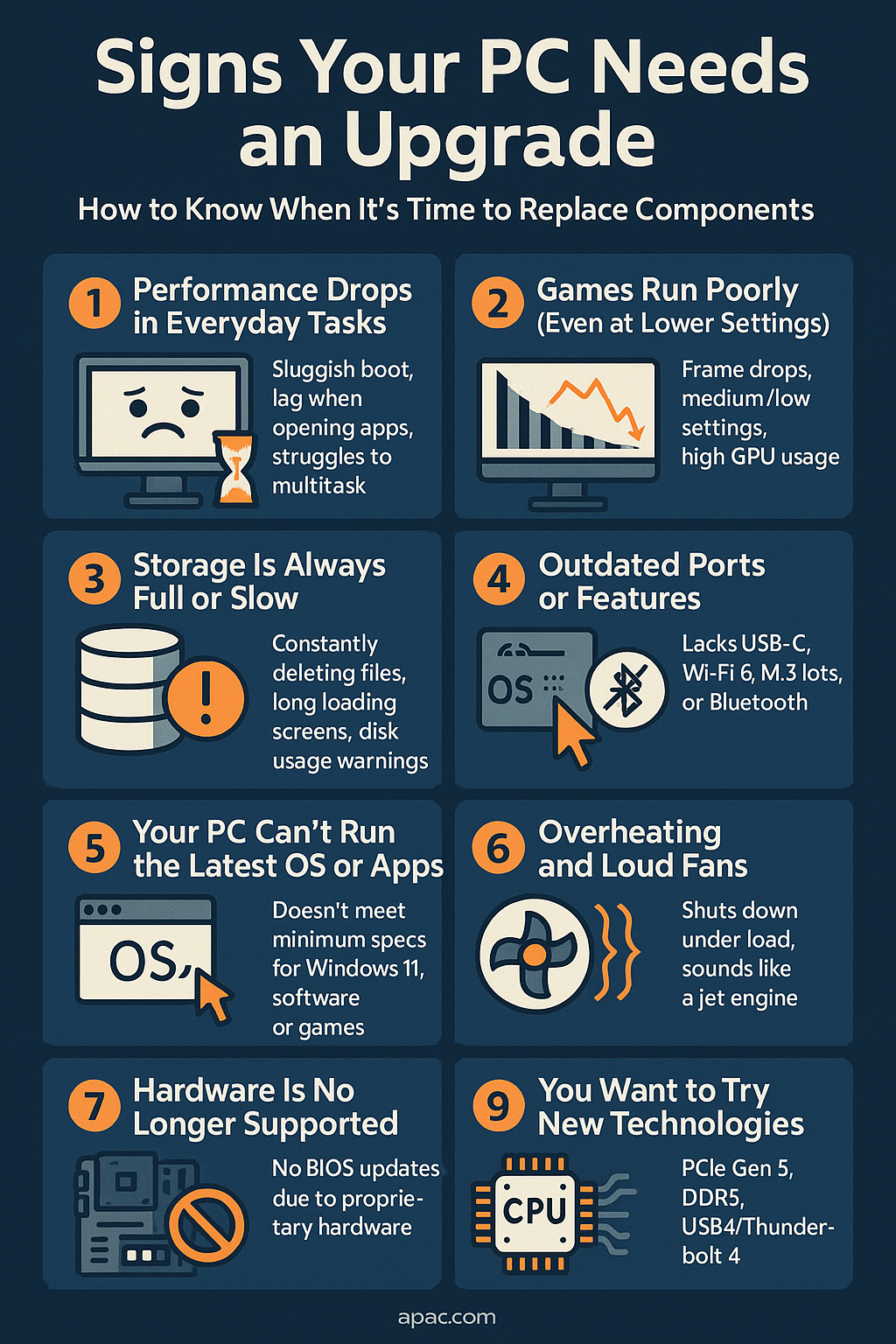Even the best-built PCs don’t last forever. Over time, software becomes more demanding, and hardware starts showing its age.
But how do you know when it’s time to upgrade your PC — and which parts should come first?
This guide helps you recognize the signs your system needs an upgrade, what to replace, and how to prioritize your next investment.
1. Performance Drops in Everyday Tasks
If your PC:
- Takes a long time to boot
- Lags when opening apps or tabs
- Stutters during video playback
- Struggles to multitask with several programs
… then it’s a strong indicator your CPU, RAM, or storage is holding you back.
✅ A simple SSD upgrade can make a 5-year-old PC feel new again.
✅ Adding more RAM boosts multitasking and browser performance.
2. Games Run Poorly (Even at Lower Settings)
Symptoms of a GPU bottleneck:
- Games drop frames frequently
- You can’t run modern titles at 1080p
- You’re stuck on medium/low settings
- GPU usage is constantly 100%, with high temps
✅ A GPU upgrade is often the best performance boost for gaming.
✅ Make sure your PSU and case can handle a newer card.
3. Storage Is Always Full or Slow
If you’re constantly deleting files, waiting on loading screens, or getting disk usage warnings, it may be time to:
- Add or upgrade to an NVMe SSD
- Replace old mechanical drives (HDDs)
- Increase total storage capacity (1TB+ for modern usage)
Faster storage = faster boot, better responsiveness, and fewer hiccups.
4. Outdated Ports or Features
Do you still have:
- USB 2.0 only?
- No USB-C support?
- No Wi-Fi 6 or Bluetooth?
- No M.2 or PCIe Gen 4 slots?
Your motherboard and case might be outdated, limiting your ability to use modern accessories and storage.
✅ Consider a full platform upgrade (CPU + motherboard + RAM) to catch up.
5. Your PC Can’t Run the Latest OS or Apps
If your system doesn’t meet the minimum specs for:
- Windows 11
- Video editing tools (Adobe, DaVinci)
- Modern games or productivity suites
…it’s time for a hardware refresh.
💡 Windows 11 requires Secure Boot and TPM 2.0 — unsupported by many older CPUs.
6. Overheating and Loud Fans
If your system sounds like a jet engine or shuts down under load, it could be:
- Thermal paste degradation
- Dust buildup in fans or heatsinks
- Weak or aging cooling components
✅ Clean your PC first
✅ Upgrade the CPU cooler or case airflow
✅ Replace old fans that no longer spin efficiently
7. Hardware Is No Longer Supported
Check if your components are on the “end-of-life” list:
- No more BIOS updates
- Drivers no longer available
- No compatibility with new GPUs or SSDs
- Manufacturer no longer lists your model
This affects future compatibility, security, and performance.
8. You’re Using a Prebuilt System from Many Years Ago
OEM desktops often use proprietary hardware that limits upgrades:
- Odd power connectors
- Locked BIOS
- Small cases with poor airflow
✅ In many cases, it’s better to build or buy a new PC than upgrade an old prebuilt.
9. You’ve Already Upgraded Everything Else
If you’ve already upgraded:
- RAM
- GPU
- SSD
- PSU
…but still feel held back, your CPU and motherboard may be the last bottleneck.
This often means a full platform change, such as going from Intel 9th Gen to 14th Gen, or from AMD AM4 to AM5.
10. You Want to Try New Technologies
Modern upgrades offer more than just speed:
- PCIe Gen 5 for SSDs and GPUs
- DDR5 RAM for future-proofing
- USB4 / Thunderbolt 4 for external displays and storage
- Integrated AI accelerators in newer CPUs
- Compact and silent builds with efficient cooling
If you’re curious about the latest tech, a new build can be a great way to explore.
Final Thoughts
Your PC doesn’t need to be the latest and greatest — but it should be reliable, responsive, and compatible with your workflow or gaming needs.
✅ If your tasks are growing and your PC can’t keep up, it’s time to plan upgrades.
✅ Prioritize the biggest bottleneck — GPU for gamers, SSD for slow systems, or RAM for multitaskers.
With the right strategy, you can breathe new life into your system — or build something better from scratch.
